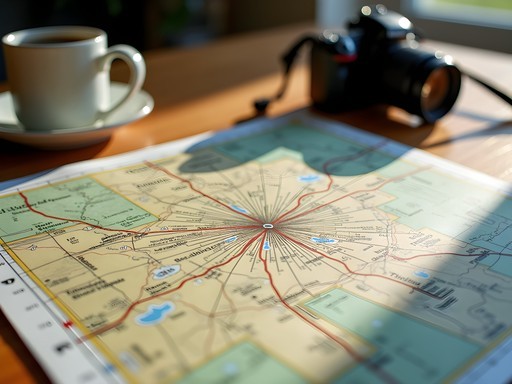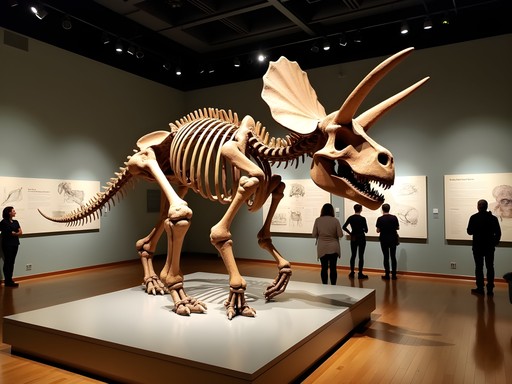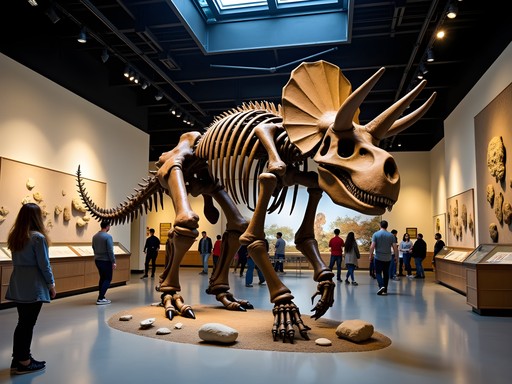Disclosure: This article contains affiliate links. We may earn a commission from purchases at no extra cost to you, which helps our travel content.
The first time I witnessed dawn breaking over the Badlands, I was rendered speechless—a rare occurrence for someone who typically narrates wildlife behaviors to anyone within earshot. The stratified buttes transformed from shadowy silhouettes to vibrant ribbons of ochre, sienna and gold as the autumn sun crested the horizon. Having photographed landscapes across Southeast Asia and Scandinavia, I wasn't prepared for how North Dakota's rugged terrain would captivate my lens. What began as a weekend detour during my veterinary conference in Bismarck evolved into a week-long love affair with the geological wonders surrounding Dickinson. This overlooked region offers photographers a rare combination: dramatic landscapes largely devoid of tourist crowds, wildlife encounters that feel genuinely wild, and skies so vast they humble even the most experienced traveler. If you've exhausted the iconic national parks and seek landscapes that challenge both your creativity and hiking boots, join me in exploring this photographer's playground where the Great Plains dramatically fracture into one of North America's most photogenic badlands.
Planning Your Badlands Photography Base Camp
After years of setting up temporary homes everywhere from floating villages in Cambodia to remote cabins in Maritime Canada, I've developed a sixth sense for selecting strategic base camps. Dickinson proved to be the perfect launching pad for my Badlands photography expedition—close enough to Theodore Roosevelt National Park to catch both golden hour and blue hour in a single day, yet equipped with the amenities needed to clean sensitive gear and review footage.
I settled into a charming Airbnb on the eastern edge of town, allowing for quick pre-dawn escapes toward the park. While chain hotels abound near the interstate, I preferred having a proper kitchen to prepare early morning thermoses of Filipino-inspired ginger tea (a family recipe that sustains me through chilly sunrise shoots).
Dickinson itself offers more than just convenience. The historic downtown provided interesting architectural subjects during midday when the harsh light made landscape photography challenging. The Dickinson Museum Center became an unexpected resource—their paleontology wing offered fascinating context about the geological forces that created the very landscapes I was photographing.
Before arriving, I mapped my week using my trusty photography planning app, which proved invaluable for calculating exactly where the sun would rise relative to key formations. The app's augmented reality feature helped me visualize potential shots days before actually taking them—essential for maximizing limited time in the field.

💡 Pro Tips
- Book accommodations on Dickinson's east side for quicker access to Theodore Roosevelt National Park
- Visit the Dickinson Museum Center for geological context that will inform your landscape composition
- Download offline maps as cell service becomes spotty in the more remote Badlands areas
The South Unit: Where Light and Landscape Collide
Theodore Roosevelt National Park's South Unit, just 40 minutes from Dickinson, became my dawn ritual during my week in North Dakota. I quickly learned that arriving at least 45 minutes before official sunrise was non-negotiable—those precious moments when the landscape transitions from blue hour to golden light create opportunities for dramatic silhouettes against the horizon.
The 36-mile Scenic Loop Drive offers numerous pullouts, but I found myself repeatedly drawn to Boicourt Overlook. This elevated vantage point provides a sweeping panorama where you can capture the sinuous curves of the Little Missouri River cutting through the badlands. During fall, the cottonwood trees lining the river valley burst into vibrant yellow, creating a stunning contrast against the rugged terrain.
My veterinary background gave me a unique appreciation for the wildlife encounters that enhanced my landscape photography. Bison frequently appeared as powerful foreground elements, their massive silhouettes adding scale and drama to the layered buttes behind them. I spent one memorable morning observing a small herd from a safe distance using my telephoto zoom lens, which provided the reach needed without disturbing these magnificent creatures.
The park's prairie dog towns offered another fascinating subject. These social creatures are most active in early morning and late afternoon—precisely when the light is most magical for photography. Their behaviors create delightful storytelling opportunities as they stand sentinel atop their mounds, backlit by golden hour light.

💡 Pro Tips
- Arrive 45 minutes before sunrise to capture the transition from blue hour to golden light
- Use a graduated neutral density filter to balance exposure between bright skies and shadowed buttes
- Keep a minimum 25-yard distance from bison while photographing—they're faster than they look
Beyond the Park: Hidden Badlands Treasures
While Theodore Roosevelt National Park rightfully commands attention, some of my most compelling images came from lesser-known locations surrounding Dickinson. The Little Missouri National Grassland—the largest accessible public grassland in the country—offers photographers a chance to capture badlands formations without another soul in sight.
Maah Daah Hey Trail, with its 144 miles of rugged pathway connecting both units of the national park, provides access to perspectives few visitors ever witness. I spent a full day hiking a 7-mile segment south of the Elkhorn Ranch Site, where the undulating landscape revealed itself in layers of increasing drama. Here, I relied heavily on my carbon fiber tripod, which proved worth every ounce of its weight when capturing tack-sharp images in the gusty prairie winds.
The area around Sentinel Butte offered another photographic treasure. This imposing landmark rises dramatically from the surrounding plains, creating opportunities for powerful compositions that emphasize scale and geological drama. I arrived mid-afternoon to scout compositions, then returned for sunset when the western light transformed the butte's face into a canvas of warm tones and deep shadows.
One unexpected discovery came through a conversation with a local rancher at a Dickinson coffee shop. After hearing about my photographic mission, he granted me permission to access his property near the Killdeer Mountains, where a hidden box canyon featured remarkably preserved petroglyphs alongside dramatic rock formations. These encounters remind me why I travel with my camera—not just to capture landscapes, but to connect with the people who know them most intimately.

💡 Pro Tips
- Pack microfiber cloths to clean your lens—the Badlands can be extremely dusty, especially in windy conditions
- Use the Maah Daah Hey Trail map to identify lesser-photographed viewpoints
- Visit local coffee shops and strike up conversations—North Dakotans often know hidden spots not found in guidebooks
Wildlife Photography: Patience and Precision
My veterinary background has taught me to read animal behavior—an invaluable skill when photographing the diverse wildlife inhabiting the Badlands ecosystem. While many visitors focus exclusively on bison (understandably so), I found myself equally captivated by the region's less celebrated residents.
The prairie falcon population provided extraordinary photographic opportunities. These agile hunters frequently perch on prominent buttes during morning hours, surveying for prey. With my background in raptor rehabilitation, I recognized their hunting patterns and positioned myself accordingly. One particularly memorable morning yielded a sequence of hunting dive images that captured the raw speed and precision of these aerial predators.
Pronghorn antelope—often mistakenly called 'pronghorn deer'—presented a different photographic challenge. These remarkably fast mammals (second only to cheetahs in land speed) require patience and telephoto reach. I spent three consecutive evenings near a watering hole in the park's western edge, using natural vegetation as a blind. The resulting images of these uniquely American ungulates silhouetted against the sunset became some of my portfolio favorites.
For serious wildlife photography in the Badlands, I relied on my telephoto lens paired with a crop-sensor camera body for maximum reach. The combination allowed me to maintain respectful distances while still capturing intimate wildlife portraits. When photographing crepuscular species (those active at dawn and dusk), I often pushed my ISO higher than comfortable, but found the grainy quality added a documentary authenticity to the images.
Remember that wildlife photography here requires both ethical awareness and safety precautions. Bison, despite their seemingly docile demeanor, remain wild animals capable of charging at speeds up to 35 mph. No photograph is worth risking your safety or disturbing these animals in their habitat.

💡 Pro Tips
- Use your vehicle as a blind when photographing roadside wildlife—animals are less threatened by cars than standing humans
- Learn to identify fresh bison tracks and scat to predict where herds might appear during golden hour
- Pack a bean bag camera support for your car window—more practical than a tripod for opportunistic wildlife shots
Mastering Night Photography in the Badlands
The Badlands transform into an otherworldly landscape after sunset, offering photographers a canvas of extraordinary potential. With minimal light pollution surrounding Dickinson and the national park, the region qualifies as a dark sky territory—perfect for astrophotography.
I dedicated two nights to capturing the Milky Way arching over distinctive Badlands formations. The Wind Canyon overlook proved particularly effective, as the curved walls created a natural leading line toward the galactic core. For these technical shoots, I relied on my night photography headlamp with its red light mode that preserved my night vision while allowing me to adjust camera settings.
Beyond traditional star photography, I experimented with light painting techniques that highlighted the textural quality of the badlands formations. Using a small tactical flashlight with adjustable beam, I gently illuminated foreground elements during long exposures, creating a three-dimensional effect that daytime photography rarely achieves.
One technique I developed specifically for the Badlands involves capturing a series of images during blue hour (just after sunset), then returning to the exact same composition after astronomical darkness for star photography. Later, I blend these exposures to create a single image that shows both the landscape detail and celestial elements with equal clarity.
The cold fall nights presented their own challenges—primarily battery drain and lens condensation when temperatures dropped. I kept spare batteries in interior pockets close to my body heat and used hand warmers secured with rubber bands around my lenses to prevent dew formation. These small adaptations made the difference between successful night shoots and frustrating technical failures.
While the photography results were spectacular, I must acknowledge the profound personal experience of standing alone beneath that vast North Dakota sky. In those quiet moments, camera clicking periodically on its timer, I felt a connection to the landscape that transcended the mere capture of images.

💡 Pro Tips
- Scout your night photography locations during daylight to identify safe shooting positions and interesting foreground elements
- Use the PhotoPills app to predict exactly when and where the Milky Way core will be visible relative to landscape features
- Bring chemical hand warmers to combat lens condensation in the cold fall nights
Final Thoughts
As I packed my gear on that final Dickinson morning, sorting through memory cards brimming with badlands imagery, I realized this overlooked corner of North Dakota had fundamentally changed my photographic perspective. The landscape's raw geological drama taught me to embrace negative space and simplicity in composition. The wildlife encounters reminded me that patience yields authenticity. And those star-filled nights reconnected me with the childlike wonder that first drew me to photography. Whether you're a seasoned photographer seeking fresh landscapes or simply someone who appreciates the meditative quality of framing the world through a viewfinder, the badlands surrounding Dickinson offer something increasingly rare: genuine discovery. The images you capture here won't just be beautiful—they'll be uniquely yours, untethered from the visual clichés of more trafficked destinations. Pack your gear, embrace the early mornings, and prepare to see this ancient landscape through new eyes.
✨ Key Takeaways
- The Dickinson area offers world-class landscape photography without the crowds of more famous national parks
- Fall brings ideal conditions: comfortable temperatures, dramatic skies, and golden cottonwood trees along river valleys
- Wildlife photography opportunities abound beyond just bison—look for pronghorn, prairie falcons, and prairie dog colonies
- Night photography in the Badlands reveals an entirely different character of the landscape worth the extra effort
📋 Practical Information
Best Time to Visit
Mid-September to late October
Budget Estimate
$1,200-$1,800 for one week (lodging, car rental, food, park fees)
Recommended Duration
5-7 days minimum
Difficulty Level
Moderate To Challenging (Requires Early Mornings, Some Hiking On Uneven Terrain)
















Comments
MidwestMom
We just got back from Dickinson last week! For anyone following Casey's advice about the hidden spots, the dirt roads can get really muddy after rain. We almost got stuck twice, so check the weather forecast before heading out to those remote areas.
vacationgal
Thanks for the heads up! Did you stay in Dickinson the whole time or camp in the park?
MidwestMom
We split our time - 3 nights in Dickinson and 2 camping. The Cottonwood Campground had amazing night sky views!
PhotoTrekker
Great post! Did you have any issues with dust on your camera sensor? I'm heading there next month and wondering if I need extra cleaning supplies.
coffeeblogger
Casey's section on "Wildlife Photography: Patience and Precision" is spot on. I spent three mornings trying to photograph bison in the fog near Buck Hill and finally got my shot on day three. The early wake-ups were brutal but so worth it! One spot not mentioned that I'd recommend is the Boicourt Overlook about an hour before sunset - the way the light rakes across the formations creates incredible texture and shadows. Dickinson was definitely the right choice for a base camp.
adventurefan
Anyone know if the wildlife is still active in November? Planning a late fall trip and wildlife photography is high on my list.
coffeeblogger
I went last November and still saw plenty of bison, pronghorn, and mule deer. The prairie dog towns were less active though. Bring warm gear - it was COLD especially for dawn shoots!
Stephanie Romano
What a fantastic guide, Casey! Reading this brought back so many memories of our family trip to the Badlands last year. We also stayed in Dickinson and found it perfect for exploring with kids. The South Unit was definitely our favorite for photography - that afternoon light on the buttes is something else. One tip for families heading there: the Painted Canyon Visitor Center has some great junior ranger activities that keep the kids engaged while you sneak in some photography time. And don't miss Medora for dinner after a day of shooting - small town but amazing food options! Looking forward to your next photography guide.
Bryce Diaz
Casey, this brought back so many memories! I spent a week photographing the Badlands last October and used Dickinson as my base too. That tip about the lesser-known viewpoints in the South Unit is gold - I found that arriving 45 minutes before official sunrise gave me the perfect blue hour shots of the formations coming alive. One spot I'd add to your list is the Boicourt Trail overlook about an hour from Dickinson. If you time it right during a full moon, you can capture the moonrise over the painted canyons. Brought my tripod which was essential for those low-light shots. For anyone following Casey's wildlife photography advice - the bison near Peaceful Valley Ranch were incredibly active around 7-8am when I visited. Just remember to keep that 75ft distance!
wildlifelover55
How difficult was tracking the bison? Planning a trip for April and wondering if I need to book a guide.
Bryce Diaz
No guide needed! The park rangers can point you to recent sightings. Just drive the scenic loop slowly and scan the grasslands. Morning and evening are best. Bring binoculars!
vacationpro
Is October too late in the year to visit? Worried about weather but would love to see fall colors if there are any.
Stephanie Romano
October can actually be wonderful! We took our family last October and the cottonwoods along the Little Missouri were stunning with golden leaves. Pack layers though - mornings can drop below freezing but afternoons were pleasant. The light is amazing that time of year too!
vacationpro
That's great to hear! Booking my trip now. Thanks!
vacationgal
Those sunrise photos are INCREDIBLE! Adding the Badlands to my bucket list right now!
Bryce Diaz
You won't regret it! The light there is unlike anywhere else I've shot.
vacationgal
Do you think it's worth visiting if I only have a smartphone camera? Not a pro like Casey!
Bryce Diaz
Absolutely! Modern smartphones handle the dramatic lighting really well. Just download a manual camera app that lets you adjust exposure. I was there last fall and got some great shots just with my phone when my main camera battery died during a sunset hike.
Sophia Gomez
Casey, this guide is exactly what I needed! I'm planning a photography trip to the Badlands this fall and Dickinson seems like the perfect home base. Your section about the 'Hidden Badlands Treasures' beyond the park boundaries is gold - those are the spots I'm most excited to explore. I had a similar speechless moment the first time I visited Badlands National Park in South Dakota, but I've heard the North Dakota badlands have a different character entirely. Planning to bring my travel tripod for those low light sunrise shots you mentioned. Thanks for sharing your insights!
luckymaster
Those bison photos are incredible! What lens did you use?
coffeeblogger
Not the author but I've shot wildlife in the Badlands before. You'll want at least a 200-300mm lens for bison, but they sometimes get surprisingly close to the roads!
Venture X
Premium card with 2X miles, $300 travel credit, Priority Pass